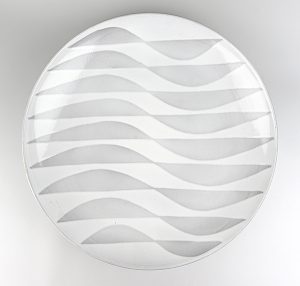

The term used for this type of decoration here is a stopgap solution because no specific term exists in the literature for this particular technique. Vessels with “brushed decoration” were made between c. 1957 and 1962 by the company “Kunstkeramik AG Luzern” under Franz Loder. The last time wares of this kind were offered for sale was in 1962 at the Mustermesse Basel (MUBA), an annual industrial fair held in the city of Basel.

Booth of the “Kunstkeramik AG Luzern” at the 1962 MUBA in Basel (photograph from the company archive now in the State Archive of Lucerne).
The shading was achieved by covering a leather-hard vessel with a thin coating of slip or glaze (using a spray gun) and then firing it for the first time. The biscuit-fired vessel was covered in a second coat of slip or glaze and, once the second coat was sufficiently dry, the patterns were applied to the bone-dry surface using a stiff-bristled brush, thus removing the top coat of slip or glaze. The next step was either to spray on a third coat of glaze (often blue), or to directly place the vessel in the kiln for its second firing. The colour shading resulted from the varying thickness of the decoration or layer of glaze.
Information on the manufacturing technique courtesy of Margret Loder, Kunstkeramik AG Luzern.
Translation Sandy Haemmerle
German: Gebürsteter Dekor
French: décor brossé

